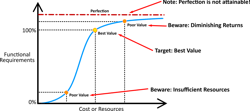This article originally appeared in the April 2021 issue of Security Business magazine. When sharing, don’t forget to mention @SecBusinessMag on Twitter and Security Business magazine on LinkedIn.
Formal Value Engineering studies can extract greater value from design projects while achieving project requirements. Because of its effectiveness, some government agencies have made value engineering a required component of major capital projects. When performed correctly – with a focus on function, alternatives, and team dynamics – Value Engineering can optimize a design so it meets required functions without sacrificing quality at a minimal cost. If performed incorrectly, such an exercise may result in a justification for cost cutting, with the key factor of “value” missing from the equation.
Incorporating a Value Engineering mindset throughout the design process can help in extracting greater value from a design. Designers, integrators, and project managers can each implement these concepts to decrease operational costs and ultimately deliver more value to the end-user.
Value Defined
Value can be defined as the simple equation of function/resources, where “Function” describes what the project,Value Engineering is a systematic process for achieving best value. It is multi-disciplinary in nature and applicable to all functional areas of an object or process. Using the equation of function/resources, the primary objective of Value Engineering is to achieve best value, not simply cut costs.
There are three primary methods by which value can be increased:
1. Increasing the function of the product or service while keeping resources constant;
2. Maintaining the function of the product or service while reducing required resources; or
3. Increasing the function of the product or service while proportionately reducing required resources.
A fourth, but less often used method of increasing value involves increasing function while increasing resources to a lesser degree (i.e., a 50% increase in function produced by a 10% increase in resources).
Principle of Best Value
The principle of Best Value requires targeting the specific Resources necessary to meet 100% of the functionalrequirements of the product or service. Poor value will result if the provided resources are insufficient to meet functional requirements, or if the assigned resources are excessive and result in diminishing returns. It should be noted that functional perfection is not attainable, regardless of the quantity of resources expended.
Getting to Best Value often requires “thinking outside the box” to expand the solution set beyond standard methods or solutions. This mode of thinking involves stretching the limits of potential solutions beyond the standards, constraints, assumptions, and design criteria that confine an initial solution set. Doing so allows for greater creativity and idea generation for meeting functional objectives and utilization of resources. Using this strategy, ideas will be developed that fall both inside and outside the initial more common solution set. In many cases, some ideas which may be infeasible can inspire unique and impactful ideas that can provide increased value.
The Value Engineering Team
Formal Value Engineering studies are typically performed by a comprehensive team of subject matter experts, led by someone highly experienced in leading Value Engineering teams and workshops – typically a Certified Value Specialist (CVS) who ensures the Value Methodology process is properly applied.
A multi-disciplinary team is assembled based on type, scale and needs of project. Common disciplines include cost estimating, architecture, various engineering disciplines (civil, structural, mechanical, electrical, IT/telecommunications, security), constructability, project risk, and others. Other disciplines include blast engineering, facilities management, construction project management, project controls management, warranty management, and commissioning.
The multi-disciplinary team is a major component to value engineering studies. Multi-disciplinary teams enable a full 360-degree assessment that involves subject matter expert input from all major disciplines. Interaction and deep discussion between team members provides unique insights from a diverse set of professional perspectives. Key issues and solutions are often identified that would be missed without team interaction.
Inside the Value Process
1. Information Phase: During the information phase, the Value Engineering team digs deep to understand the project background to make the best-informed recommendations possible. They review all available project documents, listen to owners discuss the project needs and objectives, and listen to designers present their design approaches to fulfill the need.
After collecting the available data, Value Engineering team members develop an initial cost model to identify highest cost areas of the project and provide direction for value improvements. The Value Engineering cost model is based on the Pareto Principle, which considers that often 80% of results or costs can be attributed to approximately 20% of causes or effort.
2. Functional Analysis Phase: During the functional analysis phase, the team works to understand the root functions of the project by dissecting the various sub-functions of the project and drilling down to the root functions using two-word verb-noun phrases that describe each sub-function. The team then arranges sub-function phrases using the Function Analysis System Technique (FAST) model that organizes the relationships between functions for developing shared team understanding of the project and identifying the root function of the project. Using the FAST technique also helps to identify missing functions in the project that could be easy to overlook.
3. Creative Phase: During the creative phase, the team generates ideas for alternative ways to accomplish the required functions. During this phase everything is fair game, and no area is off limits –no matter how irrational or infeasible they may initially seem. Such ideas can often help inspire truly great ideas! The goal of this phase is to generate large quantities of ideas that can be later down selected to quality ideas.
4. Evaluation Phase: During the evaluation phase, the best ideas from the creative phase are selected to develop as value alternatives. Team members vote individually to select the top ideas to move forward as value alternatives based of the four attributes of quality, benefit, innovation and acceptability. During the process, team members can advocate for individual ideas that have merit but may be overlooked in voting. It can be helpful to get preliminary stakeholder buy-in for ideas selected during the evaluation phase before fully developing the ideas.
5. Development Phase: In the developmental phase, the best alternative(s) for improving value are fully developed. Team members select individual value alternatives and then develop each through explanation in the following areas. The intent during this phase is to sell the benefit of the alternative solution to stakeholders.
- Original Concept: The concept is described in detail
- Value Alternative: The corresponding value alternative recommendation is also described in detail
- Rationale: The reason for the change is described in detail
- Advantages and Disadvantages: Pros and cons of the change are listed
- Develop cost impact: The cost impact of making the change. This includes first cost (initial cost impact resulting from the change) and lifecycle cost (long-term or recurring cost impact resulting from the change).
- Supplemental Information: Supporting images and calculations are developed to support the value alternative recommendations
6. Presentation Phase: In the presentation phase, the team members explain the developed value recommendations to project stakeholders. This includes: Value alternatives with key benefits of each; first costs and lifecycle costs for each value alternative; and the optimum combination of value alternatives.
It should be noted that stakeholder evaluation and selection of value alternatives are not typically performed in conjunction with the presentation phase. After the Value Engineering study is complete, a report is developed and submitted to the project stakeholders, from which they evaluate and select value alternatives for implementation. Value alternatives are implemented by the project design team.
Benefits and Takeaways
While a formal Value Engineering study performed by an experienced multi-disciplinary team will yield the greatest benefits, employing the Value Engineering mindset throughout design can also help to extract greater value while maintaining project requirements.
When incorporating this mindset during design, the Value Engineering process is most beneficial when it starts early in the project, when there is the greatest flexibility to develop and change design ideas. For example, it is much easier to change building geometry or layouts early in the project, but harder as the design progresses. It is also much easier to implement and allow for security features early in the project than trying to fit them into the design later in the project.
While the greatest benefits can often be achieved in the earlier phases of design, continuing this mindset throughout the design process can continue to yield benefits; however, maintaining a focus on value throughout the design process takes discipline, including maintaining a focus on the root function the design should achieve.
Close coordination and dynamic discussion with other disciplines on the design team is also a key to success in implementing the Value Engineering mindset. It is important to continually communicate and bounce ideas back and forth with other members of the design team, and to also try viewing the problem from different perspectives, and from the viewpoint of other design disciplines. Continually ask the questions ‘what-if?’ and ‘why not?’ when generating ideas and considering changes for potential value alternatives to achieve greater value from the design.
Think beyond the traditional constraints and ‘go-to’ solutions that limit decisions. While some perceived limitations are true constraints, others are not. When evaluating different design decisions, revert to the fundamental basis for assessing and increasing value to the project (Value = Function/Resources), and that value is not merely cost cutting. Additionally, it is still important to recognize when good is good enough and diminishing returns take hold.
This article is written by the team from Applied Research Associates (www.ara.com): Joseph L. Smith, PSP, Senior Vice President, and Senior Engineers J. Mikhael Erekson, P.E., and Kenneth W. Herrle, P.E., CPP, PMP.




